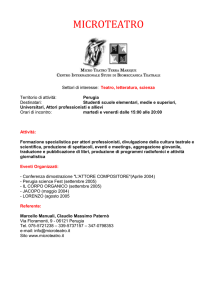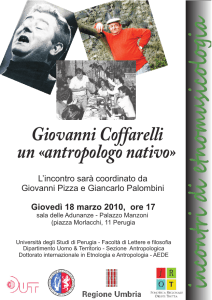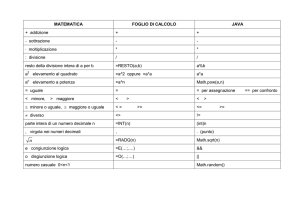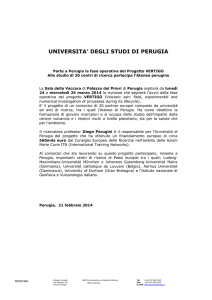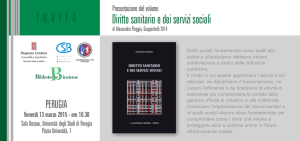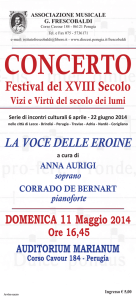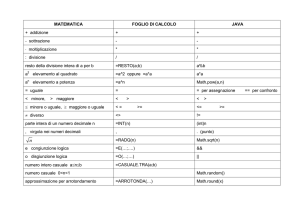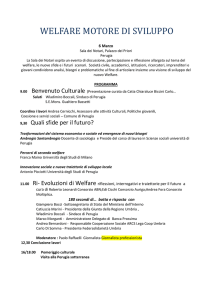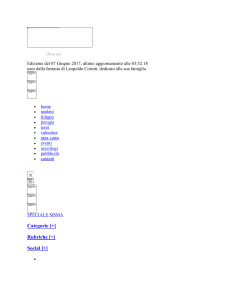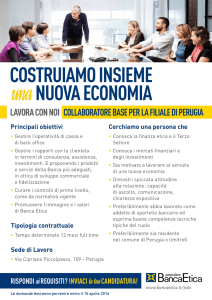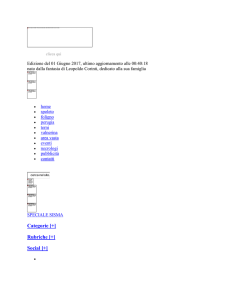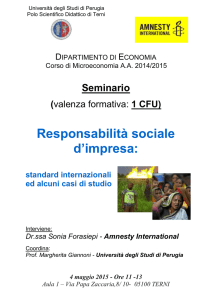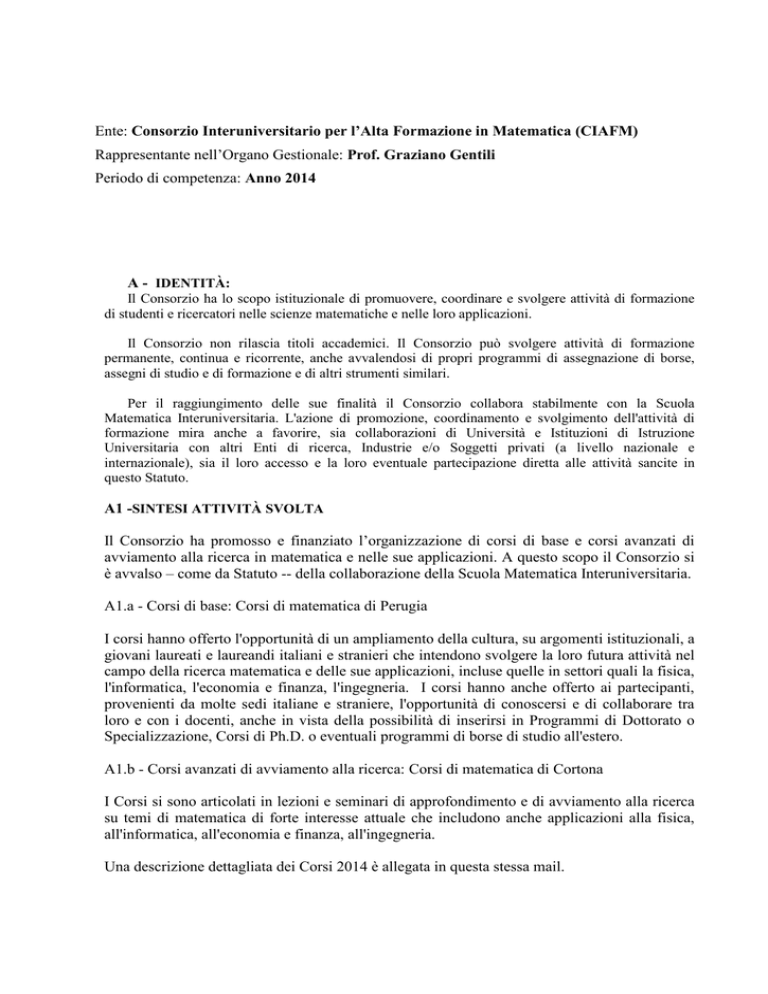
Ente: Consorzio Interuniversitario per l’Alta Formazione in Matematica (CIAFM)
Rappresentante nell’Organo Gestionale: Prof. Graziano Gentili
Periodo di competenza: Anno 2014
A - IDENTITÀ:
Il Consorzio ha lo scopo istituzionale di promuovere, coordinare e svolgere attività di formazione
di studenti e ricercatori nelle scienze matematiche e nelle loro applicazioni.
Il Consorzio non rilascia titoli accademici. Il Consorzio può svolgere attività di formazione
permanente, continua e ricorrente, anche avvalendosi di propri programmi di assegnazione di borse,
assegni di studio e di formazione e di altri strumenti similari.
Per il raggiungimento delle sue finalità il Consorzio collabora stabilmente con la Scuola
Matematica Interuniversitaria. L'azione di promozione, coordinamento e svolgimento dell'attività di
formazione mira anche a favorire, sia collaborazioni di Università e Istituzioni di Istruzione
Universitaria con altri Enti di ricerca, Industrie e/o Soggetti privati (a livello nazionale e
internazionale), sia il loro accesso e la loro eventuale partecipazione diretta alle attività sancite in
questo Statuto.
A1 -SINTESI ATTIVITÀ SVOLTA
Il Consorzio ha promosso e finanziato l’organizzazione di corsi di base e corsi avanzati di
avviamento alla ricerca in matematica e nelle sue applicazioni. A questo scopo il Consorzio si
è avvalso – come da Statuto -- della collaborazione della Scuola Matematica Interuniversitaria.
A1.a - Corsi di base: Corsi di matematica di Perugia
I corsi hanno offerto l'opportunità di un ampliamento della cultura, su argomenti istituzionali, a
giovani laureati e laureandi italiani e stranieri che intendono svolgere la loro futura attività nel
campo della ricerca matematica e delle sue applicazioni, incluse quelle in settori quali la fisica,
l'informatica, l'economia e finanza, l'ingegneria. I corsi hanno anche offerto ai partecipanti,
provenienti da molte sedi italiane e straniere, l'opportunità di conoscersi e di collaborare tra
loro e con i docenti, anche in vista della possibilità di inserirsi in Programmi di Dottorato o
Specializzazione, Corsi di Ph.D. o eventuali programmi di borse di studio all'estero.
A1.b - Corsi avanzati di avviamento alla ricerca: Corsi di matematica di Cortona
I Corsi si sono articolati in lezioni e seminari di approfondimento e di avviamento alla ricerca
su temi di matematica di forte interesse attuale che includono anche applicazioni alla fisica,
all'informatica, all'economia e finanza, all'ingegneria.
Una descrizione dettagliata dei Corsi 2014 è allegata in questa stessa mail.
A1.c - DOTTORATO CONSORTILE FIRENZE-PERUGIA-INdAM
Il Consorzio ospita tra le sue attività il Dottorato Consortile Firenze-Perugia-INdAM in
"Matematica, Informatica, Statistica", con sede amministrativa all'Università di Firenze. Tutto
questo a partire dal XXX ciclo.
L’Ente Consorziato INdAM ha finanziato n.2 borse per il Dottorato Firenze-Perugia-INdAM
in "Matematica, Informatica, Statistica", XXX ciclo.
A1-d - COLLABORAZIONE CON IL CONSORZIO MIT-ITALY
I corsi organizzati dal Consorzio sono aperti agli studenti di Ph.D. del Massachusetts Institute
of Technology. Questo avviene in relazione ad un accordo del MIT con l'Unione Matematica
Italiana.
A2 -MODELLO DI GOVERNO
-
Capitale sociale e soci in % (evidenziando % Ateneo):
Capitale Sociale: 36.000Euro
Scuola Internazionale Superiore di Studi Avanzati di Trieste (11%);
Scuola Normale Superiore di Pisa(11%);
Università di Perugia(11%);
Istituto Nazionale di Alta Matematica “Francesco Severi” (12%);
Università degli Studi di Milano-Bicocca(11%);
Politecnico di Milano(11%);
Università Bocconi(11%);
Università di Firenze(11%).
Scuola Matematica Interuniversitaria(11%);.
-
Organi di governo e composizione (evidenziando presenza Ateneo)
Direttore
Vincenzo Ancona (Istituto Nazionale di Alta Matematica - INdAM)
Consiglio dei Garanti
Vincenzo Ancona (Istituto Nazionale di Alta Matematica - INdAM)
Stefano Bianchini (Scuola Internazionale Superiore di Studi Avanzati di Trieste - SISSA)
Alessandro Figà Talamanca (Scuola Matematica Interuniversitaria - SMI)
Gianluca Vinti (Università di Perugia)
Angelo Vistoli (Scuola Normale Superiore di Pisa - SNS)
Consiglio Direttivo
Vincenzo Ancona (Istituto Nazionale di Alta Matematica - INdAM)
Stefano Bianchini (Scuola Internazionale Superiore di Studi Avanzati di Trieste - SISSA)
Alessandro Figà Talamanca (Scuola Matematica Interuniversitaria - SMI)
Graziano Gentili (Università di Firenze)
Sandro Levi (Università di Milano Bicocca)
Fabio Angelo Maccheroni (Università Bocconi)
Piercesare Secchi (Politecnico di Milano)
Gianluca Vinti (Università di Perugia)
Angelo Vistoli (Scuola Normale Superiore di Pisa - SNS)
Collegio dei Revisori dei Conti
Carlo Durante (Ministero dell’Economia e delle Finanze)
Enrico Fazzini
Sandro Valli
B - INDIVIDUAZIONE IMPATTO DI QUANTO REALIZZATO SULL’ATTIVITÀ
DELL’ATENEO:
1. finanziamenti erogati all’Ateneo (assegni di ricerca, borse di dottorato, contributi,
convenzioni conto terzi etc):
Copertura di tutte le spese per i partecipanti ai Corsi di Alta Formazione (Perugia, 5 settimane)
e Avviamento alla Ricerca (Cortona, 4 settimane).
Numero 2 Borse di Dottorato per il Dottorato Firenze-Perugia-INdAM in “Matematica,
Informatica, Statistica” (con sede Amministrativa Università di Firenze) erogate dall’INdAM
all’Università di Firenze come partecipante al Consorzio CIAFM.
2. pubblicazioni realizzate o in corso in relazione all’attività di ricerca svolta presso l’ente.
In particolare, si richiede altresì di specificare se l’Ente ha partecipato alla valutazione VQR
2004-2010 come Ente di Ricerca e con quanti docenti dell’Ateneo;
Il Consorzio non opera nella Ricerca ma nella Formazione alla Ricerca. Il CIAFM non è un
ente valutato dall’ANVUR.
3. attività di ricerca svolta attraverso strumentazione riconducibile all’Ente;
Nessuna
4. finanziamenti ottenuti dal consorzio su progetti di ricerca nazionali e internazionali
(Programma Quadro e altri bandi della Commissione Europea, Bandi Ministeriali,
Regionali, ecc.) e livello di coinvolgimento dell’Ateneo; in particolare, si richiede di indicare
se l’Ente ha inviato all’Ateneo la rendicontazione dell’entrate di cassa da Progetti di Ricerca
per l’esercizio VQR 2004-2010;
I finanziamenti al Consorzio provengono dal Miur. Nel 2014 sono stati incassati 290.000Euro
(oltre alle quote annuali versate dagli Enti Consorziati).
4.1 Partecipazione a progetti comunitari e internazionali.
Nessuna.
C – RISORSE DI ATENEO IMPIEGATE
1. Impiego del rappresentante di Ateneo (tempo);
Un totale di circa 100 ore per il 2014
2. Compenso erogato dall’Ente;
Nessuno.
3. Impegno di Altro Personale strutturato (tempo);
Nessuno.
4. Utilizzo spazi;
Nessuno.
5. Impegno di risorse umane di Ateneo, seppur non strutturate (dottorandi, assegnisti,
borsisti).
Nessuno.
Rendiconto Scientifico dell'attività “Corsi di Formazione a Avviamento alla Ricerca”,
Consorzio Interuniversitario per l’Alta Formazione in Matematica
per il 2014
1 - Elenco dei Corsi estivi tenuti nell'estate del 2014
2 - Partecipanti al Corso Estivo di Matematica - Perugia (6 corsi)
3 - Partecipanti al Corso Estivo di Matematica - Cortona (2 corsi)
4 - Elenco dei partecipanti ai singoli Corsi - Perugia
5 - Programmi dei Corsi estivi di Perugia e Cortona 2015
1
Rendiconto scientifico dell'attività della CIAFM per il 2014
Nell'estate 2014 Il Consorzio Interuniversitario per l’Alta Formazione in Matematica,
con la Collaborazione della Scuola Matematica Interuniversitaria, della Scuola Normale
Superiore di Pisa e del Dipartimento di Matematica dell'Università di Perugia, ha
organizzato corsi di base per laureandi e giovani laureati nella sede di Perugia e corsi più
avanzati, di avviamento alla ricerca a Cortona.
1 - ELENCO DEI CORSI ESTIVI TENUTI NELL'ESTATE DEL 2014
PERUGIA: (28 luglio – 29 agosto 2014)
Insegnamenti
Docenti
ALGEBRA
Thomas Weigel – Univ. Milano Bicocca
ANALISI FUNZIONALE
Michael Jury – Univ. of Florida
GEOMETRIA ALGEBRICA
Luca Chiantini – Univ. Siena
GEOMETRIA DIFFERENZIALE
Adriano Tomassini
PROCESSI STOCASTICI
Wolfgang Woess – T.U. Graz e Paolo Baldi Univ.
Univ. Parma
Roma Tor Vergata
STATISTICA MATEMATICA
Sandy Zabell – Northwestern Univ.
CORTONA
Cortona I: 21 luglio – 02 agosto 2014
AN INTRODUCTION TO CALABI’S EXTREMAIL KAEHLER METRICS
Paul Gauducion – Ecole Polytechnique Palaiseau
Cortona II: 28 luglio – 14 agosto 2014
REGULARITY TECHNIQUES and GEOMETRICAL ASPECTS in NONLINEAR PDE
Alberto Farina – Univ. De La Picardie
Ovidiu Savin – Columbia University
2 – PARTECIPANTI AL CORSO ESTIVO DI MATEMATICA – PERUGIA (6 corsi)
Studenti Italiani
Domande: 57
Studenti ammessi: 52
Partecipanti effettivi 40
Partecipanti Italiani
ADAMO Maria Stella
Università
L’Aquila
2
BOCCALETTI Simone
BONATTO Marco
BRANDI Giuseppe
BRIANTI Maro
CALUSSI Gabriele
CATALANO Anna Maria
DE CANDIA Salvatore
FASSINA MARTINO
GAMBARO Anna Maria
GARAGNANI Michele
GIOVANNINI Simone
LANCELLOTTI Benedetta
LICATA Alessandra M.A.
LOIUDICE Eugenia
LONGO Daniela
LUNARDON Luigi
MACCIONI Mauro
MALAVASI Matteo
MONTI Angela
MURATORE Giosué Emanuele
ORNAGHI Mattia
ORRU’ MOGLIA Lorenzo
PERAGINE Vitantonio
PIERONI Erika
PLATONI Irene
PORRU Paola
RAMPONI Marco
RIZZELLI Stefano
ROMANINI Giacomo
ROSAIA Nicola
SACCHI Duccio
SILVERIO Francesco
SIMI Luca
SIMONOV Nikita
SOMAGLIA Jacopo
SPEZIALI Pietro
TRESOLDI Micol Federica
VISCARDI Maria Claudia
ZINI Giovanni
Modena e Reggio Emilia
Udine
Siena
Parma
Perugia
Roma Tor Vergata
Bari
Padova
Milano Statale
Modena e Reggio Emilia
Roma La Sapienza
Milano Bicocca
Catania
Bari
della Calabria
Roma La Sapienza
Perugia
Bologna
Bari
Palermo
Milano Statale
Genova
Bari
Pisa
Perugia
Pavia
Milano Statale
L. Bocconi
Bologna
L. Bocconi
Siena
Basiicata
Firenze
Milano Bicocca
Milano Statale
Perugia
L. Bocconi
Milano Statale
Modena e Reggio Emilia
Studenti stranieri
Domande: 25
Studenti ammessi: 15
Partecipanti effettivi 7
BALGIK Irmak
BUNGARDI Sandra
CHEN Sushan
Bogazici
Babes Bolyai (ritirata prima sett. del corso)
Renmin
3
CIBUKU Denajda
COPIK Marcin
DEMIRHAN Arda
LANG Oana Andrea
MAI Long
Tirana
Silesian
Bogazici
Bucharest
Padova
3 –PARTECIPANTI AL CORSO ESTIVO DI MATEMATICA – CORTONA (2 CORSI)
Cortona I: 21 luglio – 02 agosto 2014
AN INTRODUCTION to CALABI’S EXTREMAL KAEHLER METRICS
Partecipanti Italiani
Università
Domande : 8
Ammessi : 7
Partecipanti effettivi: 7
ANGELLA Daniele
CALAMAI Simone
LANCINI Samuele
PANELLI Francesco
PETRECCA David
PLACINI Giovanni
ZEDDA Michela
Parma
Firenze
Torino
Firenze
Firenze
Pisa
Cagliari
Partecipanti stranieri
Domande : 1
Ammessi : 1
Partecipanti effettivi : 1
OTIMAN Alexandra-Giulia
Bucharest
Cortona II: 27 luglio – 14 agosto 2014
REGULARITY TECHNIQUES and GEOMETRICAL ASPETS in PDE
Studenti Italiani
Domande : 17
Ammessi : 16
Partecipanti effettivi : 11
AMBROSIO Vincenzo
BUCUR Claudia
Napoli
Milano Statale
4
BURZIO Stefano
COZZI Matteo
FORCELLA Luigi
ISERNIA Teresa
MAGLIARO Marco
PIAZZOLI Davide
PISCITELLI Gianpaolo
RIZZI Matteo
SALDI Sara
Torino
Milano Statale
L’Aquila
Napoli
Milano Statale
Parigi
Napoli
Milano Bicocca
Perugia
Studenti Stranieri
Domande : 8
Ammessi : 7
Partecipanti effettivi : 6
IOKU Norisuke
KRUPSKI Milosz
MOONEY Connor
ZHENG Xiaxin
Tohota
Wroklawski
Columbia
Wroclaw
4 – PARTECIPANTI PER SINGOLI CORSI AL CORSO ESTIVI DI PERUGIA (6 CORSI)
27 luglio – 29 agosto 2014
Algebra – (23)
Studenti italiani
ADAMO Maria Stella
BONATTO Marco
DE CANDIA Salvatore
GIOVANNINI Simone
LACELLOTTI Benedetta
LICATA Alessandra M.A.
LOIODICE Eugenia
LUNARDON Luigi
MACCIONI Mauro
MONTI Angela
MURATORE Giosuè Emanuele
PERAGINE Vitantonio
PLATONI Irene
RAMPONI Marco
SACCHI Duccio
SIMI Luca
SIMONOV Nikita
5
SPEZIALI Pietro
ZINI Giovanni
Studenti stranieri
BALGIK Irmak
CIBUKU Denajda
DEMIRHAN Arda
MAI Long
Analisi Funzionale (13)
Studenti Italiani
ADAMO Maria Stella
FASSINA Martino
GAMBARO Anna Maria
ORRU’ MOGLIA Lorenzo
ROSAIA Nicola
SILVERIO Francesco
SOMAGLIA Jacopo
TRESOLDI Micol Federica
VISCARDI Maria Claudia
Studenti stranieri
BUNGARDI Sandra
CHEN Shuhan
COPIK Marcin
LANG Oana Andrea
Geometria Algebrica (20)
Studenti Italiani
CALUSSI Gabriele
GIOVANNINI Simone
LACELLOTTI Benedetta
LICATA Alessandra M.A.
LUNARDON Luigi
MACCIONI Mauro
MONTI Angela
MURATORE Giosuè Emanuele
ORNAGHI Mattia
PERAGINE Vitantonio
PIERONI Erika
PLATONI Irene
PORRU Paola
RAMPONI Marco
SACCHI Duccio
6
SIMI Luca
SPEZIALI Pietro
ZINI Giovanni
Studenti Stranieri
BALGIK Irmak
DEMIRHAN Arda
Differential Geometry (11)
Studenti Italiani
BONATTO Marco
CALUSSI Gabriele
DE CANDIA Salvatore
FASSINA Martino
LOIUDICE Eugenia
ORNAGHI Mattia
PIERONI Erika
PORRU Paola
SILVERIO Francesco
SIMONOV Nikita
Studenti Stranieri
MAI Long
Processi Stocastici (17)
Studenti Italiani
BOCCALETTI Simone
BRANDI Giuseppe
BRIANTI Marco
CATALANO Gabriella
GAMBARO Anna Maria
GARAGNANI Michele
LONGO Daniela
MALAVASI Matteo
ORRU’ MOGLIA Lorenzo
RIZZELLI Stefano
ROMANINI Giacomo
ROSAIA Nicola
SOMAGLIA Jacopo
TRESOLDI Micol Federica
VISCARDI Maria Claudia
Studenti Stranieri
COPIK Marcin
7
LANG Oana Andrea
Statistica Matematica (12)
Studenti Italiani
BOCCALETTI Simone
BRANDI Giuseppe
BRIANTI Marco
CATALANO Gabriella
GARAGNANI Michele
LONGO Daniela
MALAVASI Matteo
RIZZELLI Stefano
ROMANINI Giacomo
Studenti Stranieri
BUNGARDI Sandra
CHEN Shuhan
CIBUKU Denajda
PROGRAMMI 2014
CORTONA 21/07 – 02/08/2014
AN INTRODUCTION TO CALABI'S EXTREMAL METRICS
Docente : PAUL GAUDUCHON – Ecole Palaiseau
SYLLABUS
_ Elements of Kahler geometry: Basic de_nitions, Kahler
identities, ddc-lemma, Ricci form, holomorphic vector _elds,
Lichnerowicz fourth-order operator etc.
_ Calabi extremal metrics: de_nitions and main properties.
_ Geometry of the space of Kahler metrics: Mabuchi energy,
Futaki invariant, geodesics, Donaldson's generalized Futaki
invariahnt, etc...
_ Examples of extremal metrics: constructions and links with
stability conditions.
References:
(1) E. Calabi, On Kahler manifolds with vanishing canonical class,
in Algebraic Geometry and Topology : A symposium in honour
of Lefschetz, Princeton University Press (1955), 78{89.
(2) E. Calabi, Extremal Kahler metrics, in Seminar of Di_ererential
Geometry, ed. S. T. Yau, Annals of Mathematics Studies 102,
Princeton University Press (1982), 259{290.
8
(3) Paul Gauduchon, Calabi's extremal metrics: An elementary introduction
(work in progress).
(4) Andrei Moroianu, Lectures on Kahler geometry. London Mathematical
society Student Texts 69, Cambridge University press,
cambridge (2007).
(5) Andr_e Weil, Introduction _a l'_etude des vari_et_es kal_eriennes, Actualit
_es Scienti_ques et Industrielles 1267, Publications de l'Universit_e
de Nancago, VI, Hermann Paris 91958).
1
Cortona 27/07 – 14/08/2014
Docenti : Alberto Farina – Univ. de la Picardie e Prof. Ovidiu Savin,
Columbia University
Qualitative properties and geometric aspects of solutions to nonlinear PDEs
SYLLABUS
_ Motivations and examples.
_ Monotonicity and one-dimensional symmetry on the entire euclidean space and in halfspaces:
Gibbons' conjecture and some open questions.
_ Pointwise gradient estimates in general domains and consequences : Liouville-type
theorems,
classi_cation of the domains and symmetry of the solutions.
_ A geometric Poincar_e-type formula and its consequences :
i) Overdetermined boundary value problems on unbounded domains and a conjecture of
Berestycki, Ca_arelli and Nirenberg,
ii) a conjecture of De Giorgi in dimension 2 and 3 (for a general nonlinearity).
_ Extensions to systems and manifolds.
BACKGROUND
Basic knowledge of : Partial Di_erential Equations, Real and Functional Analysis.
1
REFERENCES
Ambrosio, L., Cabr_e, X. Entire solutions of semilinear elliptic equations in R3 and a conjecture
of De Giorgi. J. Amer. Math. Soc. 13(4) (2000), 725-739
Berestycki, H., Ca_arelli, L., Nirenberg, L. : Symmetry for elliptic equations in a half space.
Proc. conf. in honor of E. Magenes. Boundary value problems for partial di_erential equations
and applications, 27-42, RMA Res. Notes Appl. Math., 29, Masson, Paris, 1993
Berestycki, H., Ca_arelli, L., Nirenberg, L.: Inequalities for second order elliptic equations
with applications to unbounded domains. Duke Math. J. 81(2), 467-494 (1996)
Berestycki, H., Ca_arelli, L., Nirenberg, L.: Further qualitative properties for elliptic equations
in unbounded domains. Ann. Sc. Norm. Sup. Pisa Cl. Sci. (4) 25(12), 69-94 (1997)
Berestycki, H., Ca_arelli, L., Nirenberg, L.: Monotonicity for elliptic equations in an unbounded Lipschitz domain. Comm. Pure Appl. Math. 50, 1089-1111 (1997)
Dancer, E.N.: Some notes on the method of moving planes. Bull. Aust. Math. Soc. 46(3),
9
425-434 (1992)
Damascelli, L., Sciunzi, B.: Monotonicity of the solutions of some quasilinear elliptic equations
in the half-plane, and applications. Di_. Int. Eq. 23(56), 419-434 (2010)
De Giorgi, E. : Convergence problems for functionals and operators. Proceedings of the
International Meeting on Recent Methods in Nonlinear Analysis (Rome, 1978). Pitagora,
Bologna, 1979, pp. 131-188.
Del Pino, M., Kowalczyk, M., Wei, J. : On De Giorgi's Conjecture in Dimensions N _ 9,
Annals of Mathematics 174 (2011), no. 3, 1485-1569.
Evans, L.C. : Partial Di_erential Equations, Grad. Stud. Math., vol. 19, Amer. Math. Soc.,
Providence, 1998
Farina, A. : Symmetry for solutions of semilinear elliptic equations in RN and related conjectures, Ricerche Mat. 48 (1999), no. suppl., 129-154. Papers in memory of Ennio De
Giorgi.
Farina, A. : One-dimensional symmetry for solutions of quasilinear equations in R2, Bollettino
dellUnione Matematica Italiana, Serie 8, Vol. 6-B (2003), n.3, p. 685-692.
Farina, A. : Liouville-type theorems for elliptic problems. Handbook of Di_erential Equations:
Stationary Partial Di_erential Equations, Vol. IV. Elsevier/North-Holland, Amsterdam, 2007,
pp. 61-116.
2
Farina, A., Mari, L. Valdinoci, E. : Splitting Theorems, Symmetry Results and Overdetermined
Problems for Riemannian Manifolds. Comm. Partial Di_erential Equations, 38(10):18181862, 2013.
Farina, A., Sciunzi, B., Valdinoci, E.: Bernstein and De Giorgi type problems: new results via
a geometric approach. Ann. Sc. Norm. Sup. Pisa Cl. Sci. (5) 7(4), 741-791 (2008)
Farina, A., Soave, N. : Symmetry and uniqueness of nonnegative solutions of some problems
in the halfspace. J. Math. Anal. Appl., 403(1):215-233, 2013
Farina, A., Valdinoci, E.: Flattening results for elliptic PDEs in unbounded domains with
applications to overdetermined problems. Arch. Ration. Mech. Anal. 195(3), 1025-1058
(2010)
Farina, A., Valdinoci, E. : A pointwise gradient estimate in possibly unbounded domains with
nonnegative mean curvature, Adv. Math., 225 (2010), 2808-2827.
Farina, A., Valdinoci E. : 1D symmetry for solutions of semilinear and quasilinear elliptic
equations. Trans. Amer. Math. Soc. 363(2) (2011), 579-609
Ghoussoub, N., Gui C. : On a conjecture of De Giorgi and some related problems. Math.
Ann. 311(3) (1998), 481-491.
Gibbons G.W., Townsend, P.K. : Bogomol'nyi equation for intersecting domain walls. Phys.
Rev. Lett., 83(9):1727-1730, Aug 1999
Gilbarg, D., Trudinger, N.S.: Elliptic Partial Di_erential Equations of Second Order, Classics
in Mathematics, Springer-Verlag, Berlin, 2001. Reprint of the 1998 edition.
Modica, L. : A gradient bound and a Liouville theorem for nonlinear Poisson equations,
Comm. Pure Appl. Math., 38 (1985), 679-684
Modica L., Monotonicity of the energy for entire solutions of semilinear elliptic equations,
Partial di_erential equations and the calculus of variations, Vol. II, 843-850, Progr. Nonlinear
Di_erential Equations Appl., 2, Birkhuser Boston, Boston, MA, 1989.
Pucci, P., Serrin, J.: The Maximum Principle. Birkhauser, Boston (2007)
Ros, A. Sicbaldi, P. : Geometry and topology of some overdetermined elliptic problems. J.
Di_erential Equations 255 (2013) 951-977
Savin, O. : Regularity of at level sets in phase transitions. Ann. of Math. (2) 169(1) (2009),
41-78.
Serrin, J.: A symmetry problem in potential theory. Arch. Ration. Mech. Anal. 43(4),
10
304-318 (197
11
_-REGULARITY TECHNIQUES IN PDES.
Description of the course:
The _rst part of the course will be devoted to phase transitions problems and
minimal surfaces. We will present several results in both contexts emphasizing the
common underlying ideas. Special interest will be given to atness theorems and
their application to 1D symmetry of global phase transitions and in particular to
De Giorgi's conjecture.
Some references:
Savin, O., Phase transitions, minimal surfaces and a conjecture of De Giorgi.
Current developments in mathematics, 2009, 59{113, Int. Press, Somerville, MA,
2010.
Savin, O., Regularity of at level sets in phase transitions. Ann. of Math. (2)
169 (2009), no. 1, 41{78.
Valdinoci, E.; Sciunzi, B.; Savin, O., Flat level set regularity of p-Laplace phase
transitions. Mem. Amer. Math. Soc. 182 (2006), no. 858,
Savin, O., Entire solutions to a class of fully nonlinear elliptic equations. Ann.
Sc. Norm. Super. Pisa Cl. Sci. (5) 7 (2008), no. 3, 369{405.
De Silva, D.; Savin, O., Symmetry of global solutions to a class of fully nonlinear
elliptic equations in 2D. Indiana Univ. Math. J. 58 (2009), no. 1, 301{315.
We will then present _-regularity results which share some common tools and
ideas with the results discussed in the _rst part of the course.
Some references:
Savin, O., Small perturbation solutions for elliptic equations. Comm. Partial
Di_erential Equations 32 (2007), no. 4-6, 557{578.
Wang, Y., Small perturbation solutions for parabolic equations. To appear in
Indiana University Math Journal.
De Silva, D., Free boundary regularity for a problem with right hand side. Interfaces Free Bound. 13 (2011), no. 2, 223{238.
Finally, we will see how some of these ideas extend to the case of so-called nonlocal problems.
1
2 _-REGULARITY TECHNIQUES IN PDES.
Some references:
Ca_arelli, L.; Roquejo_re, J.-M.; Savin, O., Nonlocal minimal surfaces. Comm.
Pure Appl. Math. 63 (2010), no. 9, 1111{1144.
Savin, O.; Valdinoci, E., Some monotonicity results for minimizers in the calculus of variations.J. Funct. Anal. 264 (2013), no. 10, 2469{2496.
De Silva, D.; Savin, O., C2;_ regularity of at free boundaries for the thin onephase problem. J. Di_erential Equations 253 (2012), no. 8, 2420{2459.
12
PROGRAMMI PERUGIA 29/07-29/082014
ALGEBRA
Docente – Thomas Weigel – Univ. Milano Bicocca
Semi-simple Lie Algebras
Lie Algebras play an important role in many areas of mathematics: Algebra,
differential and algebraic geometry, mathematical physics, representation theory,
etc. Although at first sight their definition might look arkward, they appear naturally
as derivation algebras of any kind of non-necessarily associative algebras. Many
results on Lie algebras can be proved by elementary methods like linear algebra and
euclidean geometry. Nevertheless, many results on Lie algebras have a strong
impact in other mathematical areas as well.
The central subject of the course will be the classification of finite-dimensional
semi-simple Lie algebra over algebraically closed fields of characteristic 0 which is
essentially due to E. Cartan. Apart from several important facts on Lie algebras of
this type, the classification is achieved by a detailed
analysis of the easiest example sl_2 of such a Lie algebra which allows to transform
the classification problem to the classification of finite euclidean reflection groups.
The latter problem can be resolved by euclidean geometry and combinatorics.
The course will be divided in two parts which will be developed independently, and
simultaneously: The structure theory of semi-simple Lie algebras, and the
classification of finite, chrystallographic root systems. Indeed, many problems on
semi-simple Lie algebras can be transferred to an equivalent problem in terms of
these root systems.
It should be mentioned that although one should consider Cartan’s classification
theorem as a classical result, it has paved the way to many new mathematical areas
which are today the subject of intensive research activity.
The course will be given in English.
R. W. Carter, Lie Algebras of Finite and Affine Type, Cambridge Studies in
Advanced Mathematics, 96, Cambridge University Press, Cambridge, 2005.
J. E. Humphreys, Introduction to Lie Algebras and Representation Theory, Graduate
Texts in Mathematics, 9, Springer-Verlag, New York, 1978.
J. E. Humphreys, Reflection Groups and Coxeter Groups, Cambridge Studies in
Advanced Mathematics, 27, Cambridge University Press, Cambridge, 1990.
N. Jacobson, Lie Algebras, Dover Publications, Inc., New York, 1979.
FUNCTIONAL ANALYSIS
Docente : Michael Jury, University of Florida
Text: A Course in Functional Analysis, John B. Conway, Springer (GTM 96)
13
The course will be a brief introduction to functional analysis, including the following
topics:
- Review of Hilbert spaces
- Operators on Hilbert space
- Banach spaces (including the Hahn-Banach theorem, the Principle of Uniform
Boundedness, open mapping and closed graph theorems, dual spaces and weak
topologies)
- An introduction to Banach algebras and C*-algebras
GEOMETRIA ALGEBRICA
- Docente : Luca Chiantini, Univ. Siena
-
-Affine and Projective varieties.
- Ideals of varieties, components, dimension.
- Regular and rational maps.
- Hilbert functions.
- Families and parameter spaces.
- Grassmannians, determinantal varieties, quotients.
- Projections and Secant varieties.
- Tangent spaces and tangential conditions.
Text: Joe Harris, Algebraic Geometry - a First Course, Springer Graduate
Text in Math 133.
GEOMETRIA DIFFERENZIALE
Docente : Adriano Tomassini – Univ. di Parma
1. Varietà differenziabili.
1.1 Preliminari topologici
1.2 Definizione di varietà. Esempi.
1.3 Spazio tangente. Applicazioni differenziabili. Differenziale. Campi
vettoriali.
1.4 Sottovarietà. Distribuzioni e Teorema di Frobenius.
2. Tensori e forme differenziali.
2.1 Algebra tensoriale. Algebra esterna
2.2 Fibrati tensoriali. Forme differenziali. L'operatore d.
2.3 Integrali di forme differenziali. Il teorema di Stokes.
14
3. Coomologia di de Rham e teoria di Hodge.
3.1 Il complesso di de Rham. Gruppi di coomologia.
3.2 Il lemma di Poincaré.
3.3 L'operatore star di Hodge.
3.4 Il teorema di Hodge. La dualità di Poincaré .
3.5 Applicazioni e calcolo della coomologia di alcuni spazi.
4. Introduzione alle varietà complesse.
4.1 Varietà complesse. Strutture complesse su spazi vettoriali.
4.2 Varietà quasi complesse. Condizione di integrabilità.
4.3 (p,q)-forme su varietà complesse. Gli operatori del e del-bar.
4.4 I gruppi di coomologia di Dolbeault di una varietà complessa.
4.5 Metriche Hermitiane e metriche Kähleriane.
4.6 Teoria di Hodge complessa.
Testi di riferimento:
[1] S.S. Chern, W.H. Chen, K.S. Lam, Lectures on Differential Geometry,
Series on University Mathematics, 1. World Scientific Publishing Co., Inc.,
River Edge, NJ, 1999. x+356 pp.
[2] W. Boothby, An introduction to differentiable manifolds and Riemannian
geometry. Second edition. Pure and Applied Mathematics, 120. Academic Press,
Inc., Orlando, FL, 1986. xvi+430 pp.
[3] F. W. Warner, Foundations of differentiable manifolds and Lie groups.
Corrected reprint of the 1971 edition. Graduate Texts in Mathematics, 94.
Springer-Verlag, New York-Berlin, 1983. ix+272 pp.
[4] J. Morrow, K. Kodaira, Complex manifolds. Reprint of the 1971 edition with
errata. AMS Chelsea Publishing, Providence, RI, 2006. x+194.
PROCESSI STOCASTICI
Docenti : W.Woess, Univ. Graz e P.Baldi. Univ. Roma Tor Vergata
Introduction to Mathematical Statistics
Scuola Matematica Interuniversitaria, Italy
Summer 2014 (July 28 – August 29)
Instructor: Professor Sandy Zabell, Department of Mathematics, Northwestern
University
Program
Week 1: Statistical models, parametric families of distributions. Normal,
gamma and beta distributions. Multivariate distributions.
Week 2: Distribution of a sum and ratio of independent random variables.
Normal distribution theory: the chi-squared, t, and F distributions. Different
forms of convergence, generating a random sample.
Week 3: Methods of estimation: method of moments, maximum likelihood,
and least squares. Criteria for evaluating point estimators: unbiased
estimation, the information inequality.
Week 4: Confidence intervals: one and two-sample estimation. Asymptotic
theory of estimators: consistency, asymptotic normality of the MLE.
Hypothesis testing, the Neyman-Pearson lemma.
Week 5: Linear regression and the general linear model, analysis of variance.
Lectures in English
15
Text: The majority of the course will be drawn from the text: Statistical
Inference (2nd ed.) by Casella and Berger; Duxbury Press, 2002.
Prerequisites: Knowledge of two years of calculus (including linear algebra)
and the basics of calculus-level probability theory will be assumed: properties
of a probability function, discrete and continuous random variables,
independence, expectation and variance. It would also be helpful if students
were familiar with the law of large numbers and the central limit theorem.e
This course is an introduction to stochastic processes with the
aim of making the students acquainted with the main basic
ideas and tools, with an outlook on some more advanced
topics. Prerequisites: it is assumed that interested
participants are already familiar with the elements that
are provided by a typical basic course in probability with
measure theory.
PROGRAM
Introductory examples.
Conditional Expectation.
Discrete time martingales.
Discrete time Markov chains.
Brownian motion and continuous time martingales.
general literature:
Gregory F. Lawler
Introduction to Stochastic Processes
Sidney I. Resnick
Adventures in Stochastic Processes
both are electronically available
Class notes also will be distributed
STATISTICA MATEMATICA
Docente : Sandy Zabell - Northwestern Univesriry
Program
Week 1: Statistical models, parametric families of distributions. Normal,
gamma and beta distributions. Multivariate distributions.
Week 2: Distribution of a sum and ratio of independent random variables.
Normal distribution theory: the chi-squared, t, and F distributions. Different
forms of convergence, generating a random sample.
Week 3: Methods of estimation: method of moments, maximum likelihood,
and least squares. Criteria for evaluating point estimators: unbiased
estimation, the information inequality.
Week 4: Confidence intervals: one and two-sample estimation. Asymptotic
theory of estimators: consistency, asymptotic normality of the MLE.
Hypothesis testing, the Neyman-Pearson lemma.
Week 5: Linear regression and the general linear model, analysis of variance.
Lectures in English
Text: The majority of the course will be drawn from the text: Statistical
16
Inference (2nd ed.) by Casella and Berger; Duxbury Press, 2002.
Prerequisites: Knowledge of two years of calculus (including linear algebra)
and the basics of calculus-level probability theory will be assumed: properties
of a probability function, discrete and continuous random variables,
independence, expectation and variance. It would also be helpful if students
were familiar with the law of large numbers and the central limit theorem.
17

